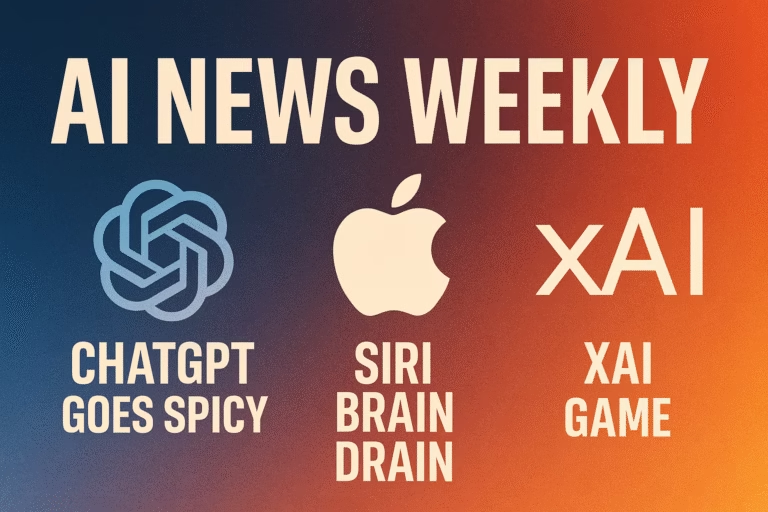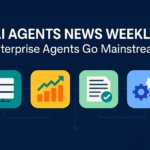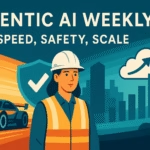Key Takeaways
- •
ChatGPT enters adults-only mode, proving AI intimacy is becoming a real market. - •
Elon Musk’s xAI is teaching AI physics through world models and an upcoming video game. - •
Microsoft’s MAI-Image-1 gives it full control of its creative AI stack for the first time. - •
AI-led self-diagnosis cases like Lyme disease hint at the future of patient-driven healthcare. - •
The IMF warns of a dot-com-style correction unless AI firms link innovation to revenue. - •
Apple’s ongoing talent exodus to Meta threatens its quiet AI strategy. - •
AI is no longer speculative — it’s embedded in daily workflows, from Gmail to Google Meet.
The AI circus added a few new acts this week.
ChatGPT wants to flirt. Elon’s building a game. Apple keeps bleeding talent like it’s fashionable. Meanwhile, Microsoft quietly dropped a serious image model, and the IMF just compared the entire AI boom to the dot-com era.
Every signal points to one truth: the novelty phase is ending. AI is entering the part where product and profit collide. This roundup filters the noise so you don’t have to scroll through hype threads or investor clickbait.
Ten headlines. Straight analysis. Let’s go.
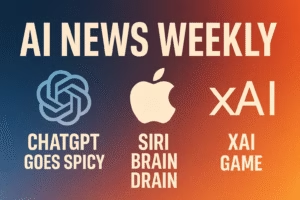
Apple’s Vision Push
Apple’s back in acquisition mode, picking up Prompt AI and its Seemour computer-vision tech. The deal folds into HomeKit, giving Apple’s ecosystem eyes that can actually understand what they’re seeing. Think smart cameras that know the difference between your cat, your kid, and the raccoon that keeps triggering alerts.
It’s Apple’s quiet way of catching up to Google’s contextual awareness without yelling “AI” every three sentences. The company still leans on privacy as its marketing halo, so expect the new features to process vision data locally rather than in the cloud.
The subtext, though, is talent. Apple keeps losing senior AI engineers to Meta, including its search lead Ke Yang. The pattern’s obvious: Apple is buying brains as fast as it’s losing them. If that leak continues, HomeKit’s new smarts may only be a temporary advantage.
xAI’s World Models and the Fully AI-Made Game
Elon Musk’s xAI announced it’s developing “world models” – mdigital environments that teach AI how movement, physics, and cause-and-effect work. The goal is for AI to stop thinking in text and start reasoning in three-dimensional logic.
Then came the twist: xAI plans to release a fully AI-generated video game next year. From storyline to physics engine, the entire thing will be built by algorithms trained inside these world models.
If it ships, it could redefine simulation. The same technology could train self-driving systems, robotics, or virtual assistants that understand the physical world rather than just describe it.
Skeptics call it marketing theater. Maybe. But Musk’s track record shows one pattern – when he mixes entertainment and infrastructure, something big usually breaks loose.
Microsoft’s MAI-Image-1 Lands with a Quiet Flex
After years of leaning on other people’s models, Microsoft finally launched its own text-to-image system, and it’s good. MAI-Image-1 is trained on Microsoft’s private datasets and integrated directly into Copilot and Designer, which means it’s built for professionals, not meme makers.
The early renders show crisp composition, better color realism, and fewer six-finger accidents than you’d expect from an early build. It’s less about art and more about ownership. Microsoft doesn’t want to depend on OpenAI forever, and this release is a signal: Redmond wants its own creative pipeline.
For businesses, this matters. You can now generate branded visuals inside Microsoft’s ecosystem without switching tools or violating licensing gray zones. For creators, it’s one more reason to keep your workflow close to where your data already lives.
This is the beginning of Microsoft’s generative independence. When a company that large stops borrowing tech and starts building it, competitors usually feel it.
Patient-Led Diagnostics Are Here
Some stories sneak up on the industry but define its direction. In the UK, a man diagnosed himself with Lyme disease using an open AI model after several doctors dismissed his symptoms. The AI pulled pattern matches across symptoms and clinical data sets – and got it right.
That single success story rattled healthcare Twitter for a reason. It hints at a shift from doctor-driven to data-driven diagnosis. When access to accurate models becomes universal, expertise stops being a bottleneck.
Hospitals hate that idea. Regulators fear it. Patients, however, are starting to test it.
AI doesn’t replace doctors, but it will change how people seek them. The first step in every medical journey is information, and the machine now answers faster, cheaper, and sometimes better.
Healthcare’s problem isn’t intelligence. It’s permission. And patients are no longer waiting for it.
ChatGPT’s Adults-Only Mode
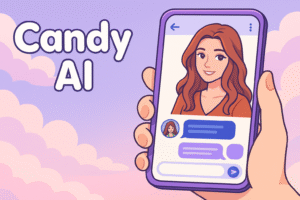
OpenAI is stepping into territory most tech companies pretend doesn’t exist. The company confirmed that verified adults will soon gain access to mature and romantic chat features inside ChatGPT.
The announcement was framed as a freedom-of-choice update – “Treat adults like adults,” said Sam Altman – but it’s also a smart commercial move.
Platforms like Candy AI and Crushon AI have already proven there’s demand for AI intimacy. Altman’s team is simply bringing that market in-house.
For creators, this signals a larger shift. The next wave of AI isn’t just about productivity; it’s about personality. Whether that’s healthy or horrifying depends on who’s holding the keyboard.
From a business standpoint, OpenAI is testing emotional bandwidth as a feature. If people already trust the model with secrets, giving it permission to get personal isn’t much of a stretch.
The challenge will be content moderation. A single misstep could trigger backlash from both regulators and parents’ groups.
Still, it’s a bold move that may redefine what “conversation AI” really means. OpenAI is betting that intimacy, handled responsibly, is the next billion-dollar interface.
IMF: Bubble Vibes, Different Money
The International Monetary Fund dropped its own kind of mic this week. In a report comparing today’s AI investment boom to the dot-com bubble, it argued that we’re seeing the same speculative rhythm-minus the debt.
This time, the money isn’t borrowed. It’s cash from corporations and high-net-worth investors chasing relevance before the market settles. That distinction makes the fallout, if it comes, less catastrophic. But it also means investors are more impatient. They’ll want results faster.
The IMF’s warning is less about panic and more about pacing. It’s telling founders and funds alike: the easy money phase is ending. The next cycle will reward businesses that tie AI innovation to sustainable margins.
If the 90s taught anything, it’s that a working business model beats a clever demo. This round of AI history will make the same point — just more expensively.
Gmail’s Gemini Scheduling Feature Fixes Calendar Chaos
If your inbox looks like a graveyard of “let’s find a time” threads, Google just threw you a rope. The company rolled out “Help me schedule”, a Gemini-powered assistant built right into Gmail that reads conversations, identifies everyone’s availability, and drafts suggested meeting times automatically.
This isn’t just automation – it’s social calculus. Gemini parses tone, intent, and context, so it knows that “next week works” probably means “not Monday morning.” It can even differentiate between internal and external stakeholders and propose options that respect time zones and working hours.
For individuals, it’s convenience. For businesses, it’s a quiet productivity multiplier. The scheduling black hole that swallows hours every week might finally close.
Of course, the privacy question hangs overhead. Letting AI read every email to plan meetings feels like giving a butler the keys to your diary. Still, if it works as advertised, managers might stop playing tag through twenty-message chains a win worth the tradeoff.
Nvidia’s Compute Empire Levels Out
After a year of runaway demand, Nvidia’s dominance in the compute market is finally stabilising. Global compute capacity has grown by 100 times since 2020, and the fever pitch around AI training is cooling. Supply chains are catching up, pricing pressure is easing, and a new equilibrium is forming.
That doesn’t mean Nvidia’s reign is ending it means the gold rush phase is closing. The company remains the backbone of modern AI infrastructure, but attention is shifting toward efficiency, not expansion.
Startups and data centers are now optimising models to use fewer GPUs, while competitors like AMD and Intel are introducing cost-effective alternatives. Even cloud providers are building their own silicon.
For investors, this moment defines a pivot from speculative hardware growth to operational discipline. Compute isn’t infinite anymore. It’s the new oil valuable, scarce, and political. Whoever controls the flow will shape the future of AI pricing.
Google Meet’s Makeup Filters Are Uncanny
Google Meet now ships with Gemini-powered makeup filters that cling to your face even when you move, sip coffee, or tilt your head. The AI tracks facial depth and lighting conditions, ensuring your foundation never fades mid-call.
It’s hilarious and impressive at once. You can now show up to a 9 a.m. meeting looking like you’ve had eight hours of sleep, even if you’ve had two.
Underneath the gimmick is something bigger: real-time computer vision that handles precision layering. That tech is the same backbone that powers AR surgery, driver safety systems, and next-gen visual effects.
The filters might look like vanity, but the underlying capability is a cornerstone of spatial computing.
Google knows it. The “beauty filter” is just a test case for live, on-device rendering. The next step is full facial mapping -not for looks, but for identity, security, and accessibility. The line between camera features and biometric systems is getting very thin.
Apple’s Talent Outflow Keeps Growing
Apple might make beautiful hardware, but its people are voting with their feet. The company just lost Ke Yang, its AI search lead, to Meta – one more in a series of quiet but steady defections.
Meta isn’t stealing rookies. It’s hiring Apple’s top infrastructure engineers, the ones who understand large-scale data orchestration and privacy design. These aren’t cosmetic hires; they’re the backbone of modern AI development.
Apple’s strategy has always been to build in silence, but in 2025, silence reads like stagnation. The company risks becoming the BlackBerry of AI if it can’t retain or replace this level of talent.
Meanwhile, Meta keeps evolving into the world’s most unpredictable AI player – chaotic, experimental, but undeniably bold. If Apple doesn’t fix its internal culture soon, its next breakthrough may end up being someone else’s press release.
Winding Up
Ten stories. One pattern.
AI is no longer a research race – it’s a credibility contest. The winners are the teams who can turn novelty into usable products that survive public scrutiny.
Elon’s turning physics into games. Sam Altman is rewriting what’s acceptable AI conversation. Google’s turning productivity into predictive empathy. Apple’s trying to plug a talent drain.
We’re past the point of “AI someday.” It’s already in your inbox, your workflow, your meetings, and, apparently, your makeup.
